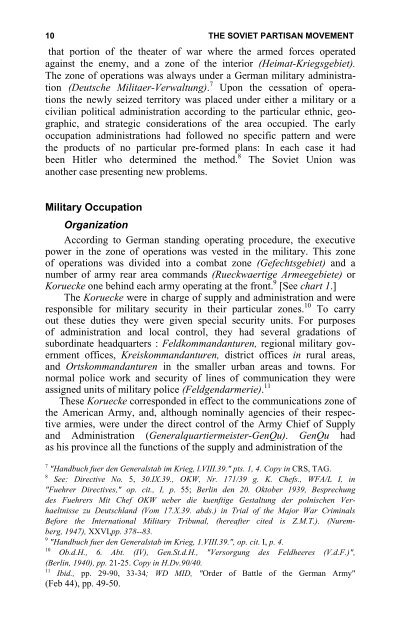the soviet partisan movement 1941-1944 by edgar m. howell
the soviet partisan movement 1941-1944 by edgar m. howell
the soviet partisan movement 1941-1944 by edgar m. howell
You also want an ePaper? Increase the reach of your titles
YUMPU automatically turns print PDFs into web optimized ePapers that Google loves.
10 THE SOVIET PARTISAN MOVEMENT<br />
that portion of <strong>the</strong> <strong>the</strong>ater of war where <strong>the</strong> armed forces operated<br />
against <strong>the</strong> enemy, and a zone of <strong>the</strong> interior (Heimat-Kriegsgebiet).<br />
The zone of operations was always under a German military administration<br />
(Deutsche Militaer-Verwaltung). 7 Upon <strong>the</strong> cessation of operations<br />
<strong>the</strong> newly seized territory was placed under ei<strong>the</strong>r a military or a<br />
civilian political administration according to <strong>the</strong> particular ethnic, geographic,<br />
and strategic considerations of <strong>the</strong> area occupied. The early<br />
occupation administrations had followed no specific pattern and were<br />
<strong>the</strong> products of no particular pre-formed plans: In each case it had<br />
been Hitler who determined <strong>the</strong> method. 8 The Soviet Union was<br />
ano<strong>the</strong>r case presenting new problems.<br />
Military Occupation<br />
Organization<br />
According to German standing operating procedure, <strong>the</strong> executive<br />
power in <strong>the</strong> zone of operations was vested in <strong>the</strong> military. This zone<br />
of operations was divided into a combat zone (Gefechtsgebiet) and a<br />
number of army rear area commands (Rueckwaertige Armeegebiete) or<br />
Koruecke one behind each army operating at <strong>the</strong> front. 9 [See chart 1.]<br />
The Koruecke were in charge of supply and administration and were<br />
responsible for military security in <strong>the</strong>ir particular zones. 10 To carry<br />
out <strong>the</strong>se duties <strong>the</strong>y were given special security units. For purposes<br />
of administration and local control, <strong>the</strong>y had several gradations of<br />
subordinate headquarters : Feldkommandanturen, regional military government<br />
offices, Kreiskommandanturen, district offices in rural areas,<br />
and Ortskommandanturen in <strong>the</strong> smaller urban areas and towns. For<br />
normal police work and security of lines of communication <strong>the</strong>y were<br />
assigned units of military police (Feldgendarmerie). 11<br />
These Koruecke corresponded in effect to <strong>the</strong> communications zone of<br />
<strong>the</strong> American Army, and, although nominally agencies of <strong>the</strong>ir respective<br />
armies, were under <strong>the</strong> direct control of <strong>the</strong> Army Chief of Supply<br />
and Administration (Generalquartiermeister-GenQu). GenQu had<br />
as his province all <strong>the</strong> functions of <strong>the</strong> supply and administration of <strong>the</strong><br />
7 "Handbuch fuer den Generalstab im Krieg, l.VIII.39." pts. 1, 4. Copy in CRS, TAG. <br />
8<br />
See: Directive No. 5, 30.IX.39., OKW, Nr. 171/39 g. K. Chefs., WFA/L I, in<br />
"Fuehrer Directives," op. cit., I, p. 55; Berlin den 20. Oktober 1939, Besprechung<br />
des Fuehrers Mit Chef OKW ueber die kuenftige Gestaltung der polnischen Verhaeltnisse<br />
zu Deutschland (Vom 17.X.39. abds.) in Trial of <strong>the</strong> Major War Criminals<br />
Before <strong>the</strong> International Military Tribunal, (hereafter cited is Z.M.T.). (Nuremberg,<br />
1947), XXVI,pp. 378--83.<br />
9<br />
"Handbuch fuer den Generalstab im Krieg, 1.VIII.39.", op. cit. I, p. 4.<br />
10<br />
Ob.d.H., 6. Abt. (IV), Gen.St.d.H., "Versorgung des Feldheeres (V.d.F.)",<br />
(Berlin, 1940), pp. 21-25. Copy in H.Dv.90/40.<br />
11<br />
Ibid., pp. 29-90, 33-34; WD MID, "Order of Battle of <strong>the</strong> German Army"<br />
(Feb 44), pp. 49-50.
















